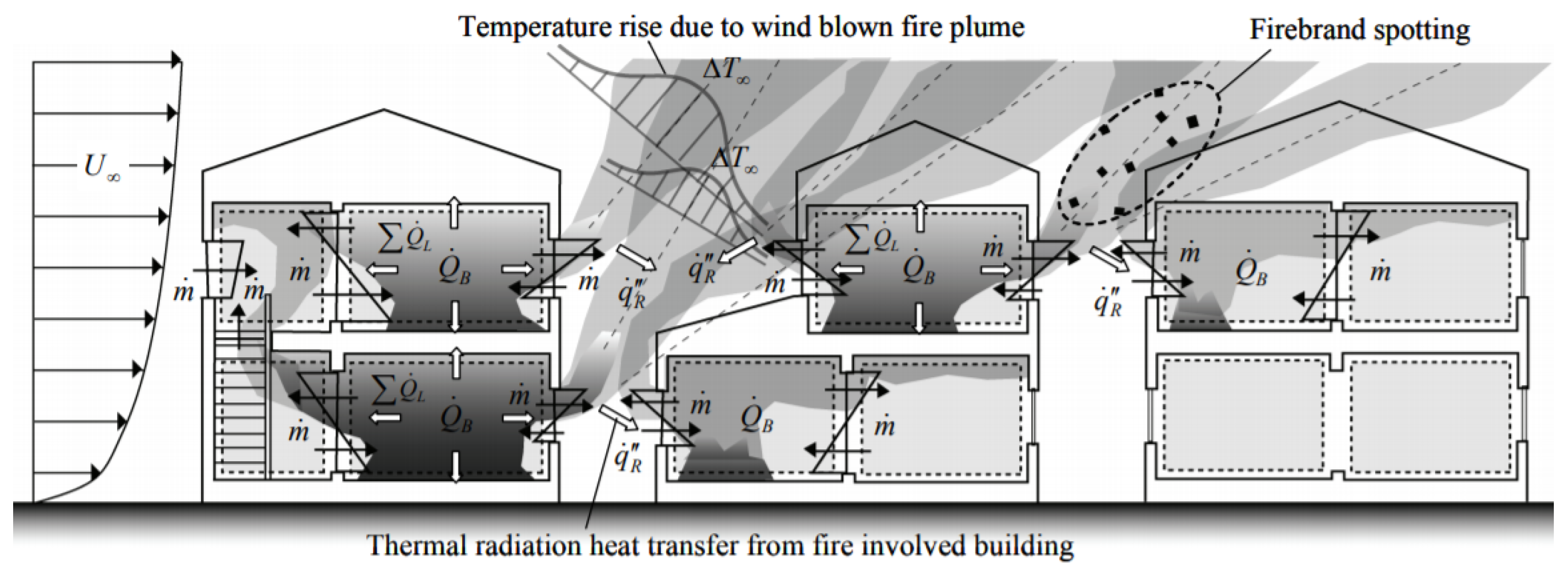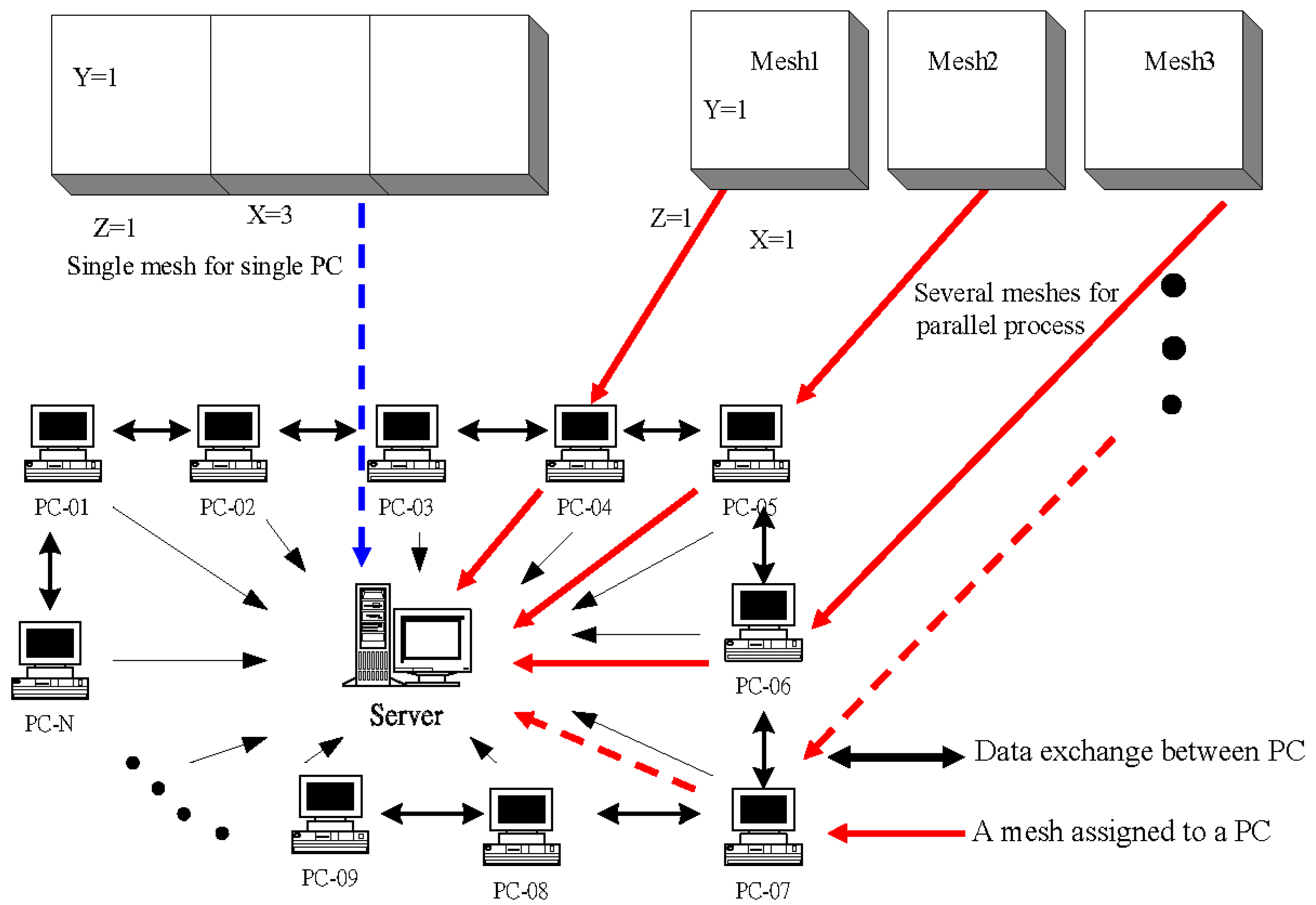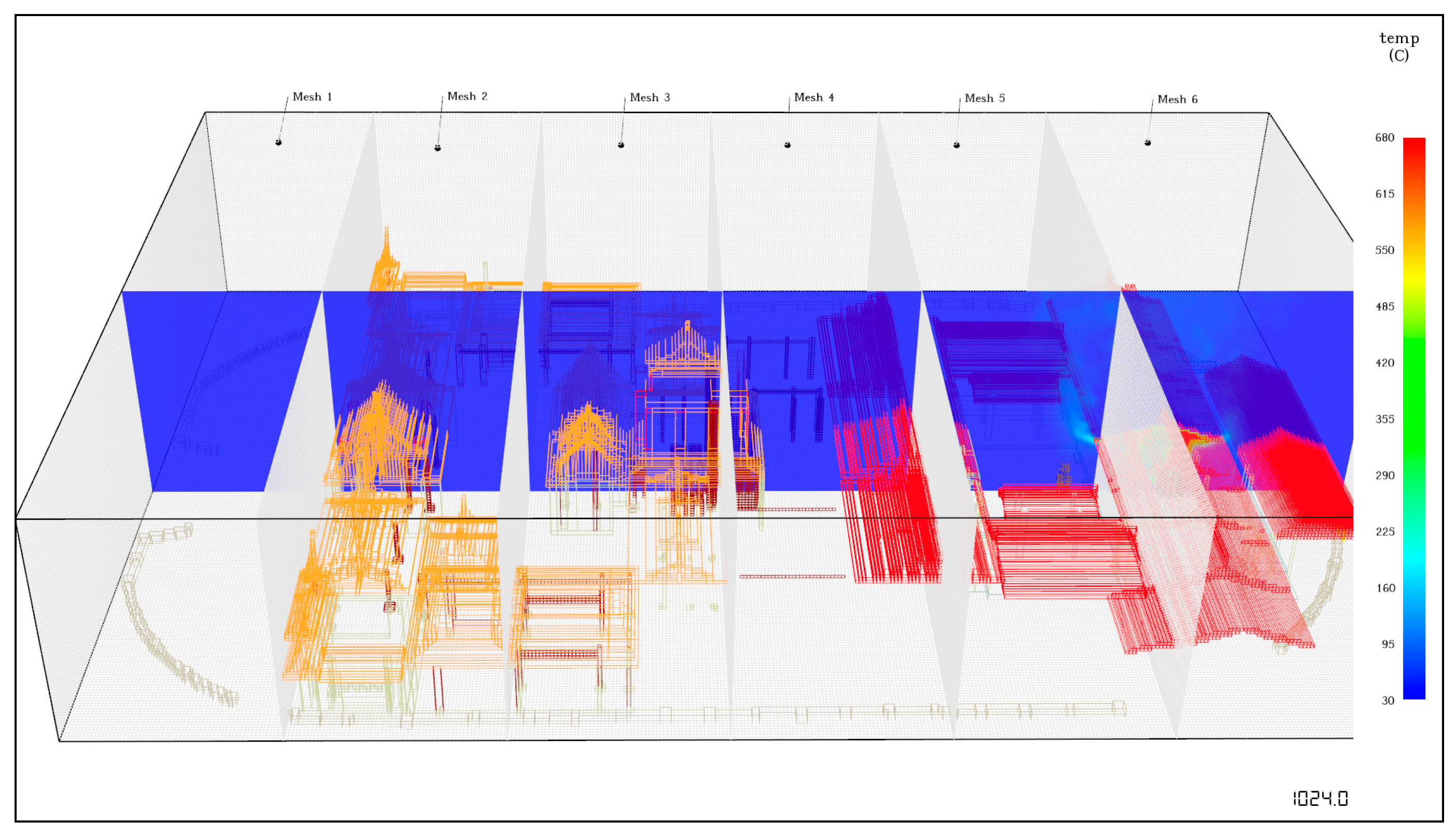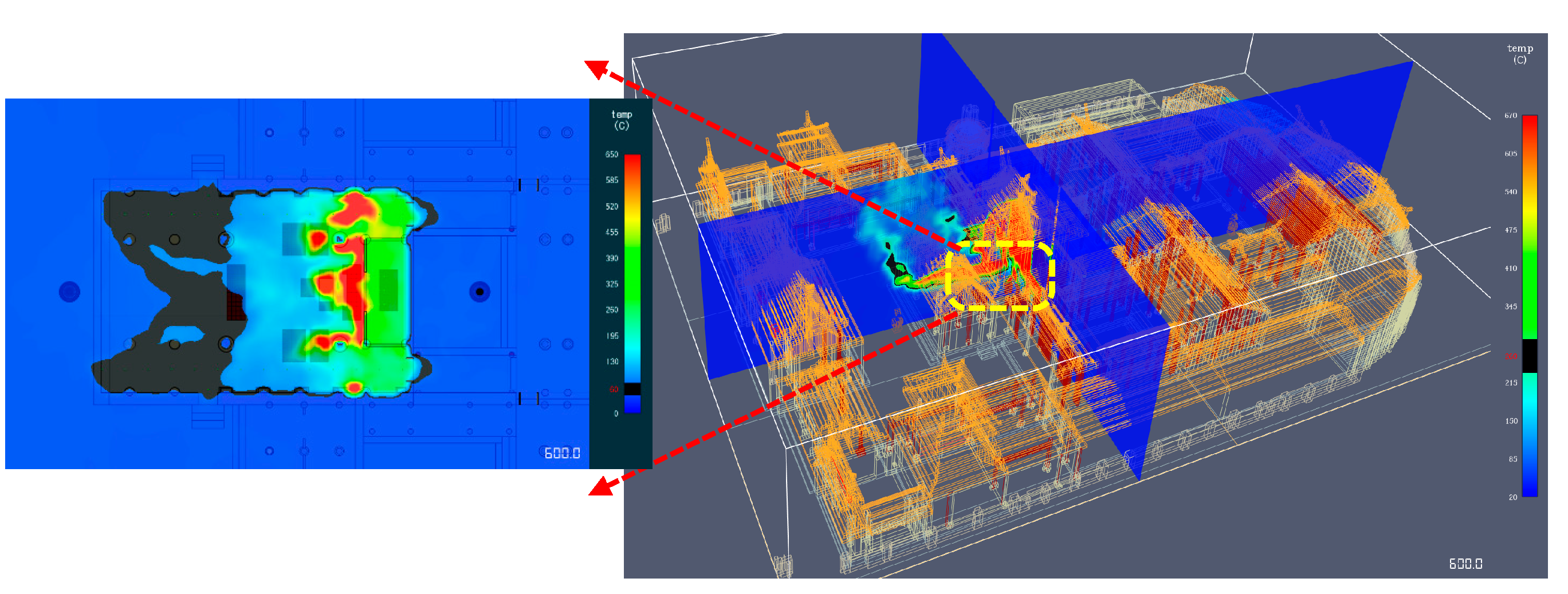The Use of Parallel Computing to Accelerate Fire Simulations for Cultural Heritage Buildings
Abstract
1. Introduction
2. Protection of Tangible Cultural Heritage
2.1. Sendai Declaration and Sendai Framework for Disaster Risk Reduction 2015–2030
- Understanding disaster risk;
- Strengthening disaster risk governance to manage disaster risk;
- Investing in disaster risk reduction for resilience;
- Enhancing disaster preparedness for effective response, and to “build back better” in recovery, rehabilitation, and reconstruction [4].
2.2. The Research Object: Tangible Cultural Heritage in Taiwan
3. Post-Disaster Assessment
3.1. Tangible Cultural Heritage Fires in Taiwan
3.2. Fire Simulation Steps for Tangible Cultural Heritage
4. Research Methods and Applications
4.1. Risk Assessment and Field Survey
4.2. Computer Simulation
4.3. Mesh for the FDS Parallel Process
5. Concluding Remarks
- The simulation of full-scale building fires is more valuable than the simulation of specific narrow ranges, because it provides an evaluation of the whole area in a fire scenario, especially for fire spread among groups of building as occurred in the Shuri Castle fire on 31 October 2019. This study completed a full-scale simulation replicating a real area of 76 m × 45 m × 15 m with nine temples by 6.4 million grids, with a calculation of 600 s simulation time in 45 h. This surpasses the results from previous cases and provides a better research method in the full-scale range, thereby validating the fire simulation for tangible cultural heritage sites for their protection in this field.
- A temperature of 670 °C could be reached in 10 min due to a general fire source with damage to adjacent buildings. Historical buildings are dominated by wooden structures, and this study highlighted 10 min as the critical time for an emergency response.
- Historic buildings may be exempt from the requirements of automatic fire extinguishing systems and fire safety regulations in order to keep their original appearance. However, if there is an identification or risk via a communication exercise at this critical time, the 119 automatic notification system can be linked to a fire alarm system. The golden response time can, thus, still be achieved, and the fire can be limited to the initial room, especially for historical temples without proper security measures.
Funding
Conflicts of Interest
References
- UNESCO. Sendai Declaration of the Third World Conference on Disaster Risk Reduction; United Nations: Sendai, Japan, 2015; Available online: https://www.unisdr.org/files/45069_proceedingsthirdunitednationsworldc.pdf (accessed on 21 August 2019).
- UNESCO. Strategy for Reducing Risks from Disasters at World Heritage Properties; United Nations: Christchurch, New Zealand, 2007; Available online: https://whc.unesco.org/archive/2007/whc07-31com-72e.pdf (accessed on 14 February 2020).
- UNESCO. Harmonizing Actions to Reduce Risks for Cultural Heritage in Asia and the Pacific; United Nations: Penang, Malaysia, 2015. [Google Scholar]
- Sendai Framework for Disaster Risk Reduction 2015–2030. Available online: https://www.unisdr.org/we/coordinate/sendai-framework (accessed on 15 February 2020).
- National Disaster Management Guidelines for Cultural Heritage Sites and Precincts; National Disaster Management Authority: New Delhi, India, 2017.
- ICORP. Heritage and Resilience: Issues and Opportunities for Reducing Disaster Risks; United Nations: Geneva, Switzerland, 2013. [Google Scholar]
- IPCC. Managing the Risks of Extreme Events and Disasters to Advance Climate Change Adaptation; Cambridge University Press: Cambridge, UK, 2012. [Google Scholar]
- ICOMOS 2017 Annual Report; ICOMOS: Paris, France, 2017.
- Feng, W.-H. Historical District Fire Risk Analysis and Fire Spread Models—A Case Study on Taipei DiHua Street. Msater’s Thesis, Central Police University, Taoyuan City, Taiwan, 2016. [Google Scholar]
- Chen, J.L.; Wen, I.-J.; Lee, M.-C. A Study on Fire Risk Assessment of Monument and Historic Buildings in Taiwan; Ministry of Interior Architecture Institute: New Taipei City, Taiwan, 2011. [Google Scholar]
- Chiang, P.-Y.; Huang, Y.-H. Fire Case Analysis of Tangible Cultural Heritages. J. Disaster Mitig. Rescue 2018, 19, 19–40. [Google Scholar]
- Marrion, C.E. More effectively addressing fire/disaster challenges to protect our cultural heritage. J. Cult. Herit. 2016, 20, 746–749. [Google Scholar] [CrossRef]
- NFPA 914: Code for the Protection of Historic Structures; NFPA: Quincy, MA, USA, 2019.
- Himoto, K.; Tanaka, T. Development and validation of a physics-based urban fire spread model. Fire Saf. J. 2008, 43, 477–494. [Google Scholar] [CrossRef]
- Shoseyama, S. Fire damage prediction method in earthquake damage prediction survey. J. Jpn. Fire Assoc. 2015, 65, 26–32. [Google Scholar]
- Hsu, W.-S.; Huang, Y.-H.; Shen, T.-S.; Cheng, C.-Y.; Chen, T.-Y. Analysis of the Hsuehshan Tunnel Fire in Taiwan. Tunn. Undergr. Space Technol. 2017, 69, 108–115. [Google Scholar] [CrossRef]
- Shen, T.-S.; Huang, Y.-H.; Chien, S.-W. Using fire dynamic simulation (FDS) to reconstruct an arson fire scene. Build. Environ. 2008, 43, 1036–1045. [Google Scholar] [CrossRef]
- Huang, Y.-H. Fire Risk Assessment of Tangible Cultural Heritages and Historic Buildings. In Special Lecture on Disaster Prevention and Rescue of Culture Monuments; Fire Department: New Taipei City, Taiwan, 2019; pp. 17–32. [Google Scholar]
- McGrattan, K.; McDermott, R.; Vanella, M. Fire Dynamics Simulator—User’s Guide, Version 6.7.3; National Institute of Standards and Technology: Gaithersburg, MA, USA, 2019; pp. 5–11. [Google Scholar]
- Huang, Y.-H. Fire Scene Reconstructed Simulation of Tangible Cultural Heritage—Taking Beigang Chaotian Temple as an Example. Police Sci. Bimon. 2020, 51, 45–60. [Google Scholar]
- Chiang, P.-Y. Research on Performance-Based Design of Fire Safety System in Tangible Cultural Heritages—The Case of Beigang Chao-Tian Temple. Master’s Thesis, Central Police University, Taoyuan City, Taiwan, 2019; p. 97. [Google Scholar]





| Risk resilience | The ability of a system to anticipate, absorb, accommodate, or recover from disaster in a timely and efficient manner [6,7]. |
| Harmonization | For cultural heritage, the function of harmonization is not limited to the final education and training; rather, the concept should be included in the initial stage of risk identification. |
| Reconstruction and building back better [4] | Heritage and Democracy was the central theme of the 19th ICOMOS Scientific Symposium, 2017. In addition to the formal considerations for the post-disaster reconstruction, the original materials, construction methods, and participation in the local community should be reproduced. |
| Implementation of technology [8] | The application of science and technology in the management of cultural heritage disaster risk, including the identification of historical materials and components, three-dimensional (3D) scanning technology, risk prediction and assessment, and building disaster resistance assessment (e.g., earthquake and fire), especially with fire as a research focus. |
| Year | Time | Case | City | Cause | Category | |
|---|---|---|---|---|---|---|
| Occurred | Registered | |||||
| 2008 | 2018 | 2:00 | Luchou Lee Family estate | New Taipei City | Intentional | Monument |
| 2008 | 2007 | 3:00 | Dihua Street | Taipei City | EM | Historic Arch. |
| 2009 | 2005 | 22:46 | Chiang Kai-Shek Shilin Residence | Taipei City | EM | Monument |
| 2010 | 2003 | 15:00 | Taisugar Taipei warehouse | Taipei City | Careless | Monument |
| 2010 | 2004 | 2:36 | Shueijiaoshe Cultural Park | Tainan City | Intentional | Monument |
| 2010 | 1985 | 0:00 | Miaoli Wen-Chang Temple | Miaoli County | EM | Monument |
| 2012 | 1985 | 2:00 | Fengshan Longshan Temple | Kaohsiung City | Intentional | Monument |
| 2013 | 2015 | 21:22 | Fengyuan Forestry Bureau Dormitory Group | Taichung City | Unknown | Historic Arch. |
| 2013 | 2005 | 3:00 | Shuili Checheng Dormitory Group | Nantou County | Intentional | Historic Arch. |
| 2013 | 2003 | 0:23 | Puzi Pei-Tian Temple | Chiayi County | Careless | Monument |
| 2013 | 2003 | 7:40 | Zhengbin Building of Fishermen’s Association | Keelung City | EM | Historic Arch. |
| 2014 | 2014 | 5:00 | Keelung Harbor West Second Warehouse | Keelung City | EM | Historic Arch. |
| 2016 | 2006 | 12:20 | Former South Garden Japanese-style dorm. group | Taipei City | Other heat | Monument |
| 2016 | 2000 | 5:30 | Lugang Fengshan Temple | Changhua County | Careless | Monument |
| 2016 | 2007 | 12:59 | Taiwan Railways Dormitory group, Lane 38, Zhengzhou Road | Taipei City | Intentional | Monument |
| 2016 | 2014 | 5:11 | Affiliated buildings of Taichung City Hall | Taichung City | Careless | Historic Arch. |
| 2016 | 2016 | 17:06 | Taichung Train Station Dormitory group | Taichung City | Careless | Monument |
| 2016 | 2015 | 16:58 | Huwei Jianguo Second Village * | Yunlin County | Intentional | Cluster |
| 2016 | 2013 | 3:43 | Former Taipei Criminal Office Dormitory group | Taipei City | Intentional | Historic Arch. |
| 2017 | 2013 | 20:13 | Yangmingshan American Military Housing | Taipei City | Careless | Cultural Arts |
| 2017 | 1985 | 14:00 | Changhua Guandi Temple | Changhua County | Careless | Monument |
| Country | Year | Evolution Disaster | Change | |
|---|---|---|---|---|
| Act | Memorial Day | |||
| Japan | 1949 | Hōryū-ji Fire | Cultural Properties Protection Act | January 26 Cultural Heritage Fire Safety Day |
| South Korea | 2008 | Namdaemun Fire | Cultural Heritage Protection Act | February 10 Cultural Heritage Fire Safety Day |
| Taiwan | 1999 | September 21 Earthquake | Major Disaster Response Measures for Monuments and Historic Buildings | September 21 Disaster prevention day |
| 2016 | A series of fires and Intentional damage | Cultural Heritage Preservation Act | September, Cultural Heritage Disaster prevention month | |
| India | 2001 2011 2017 | Bhuj Earthquake Sikkim Earthquake China–India Darjeeling Event | National Disaster Management Guidelines for Cultural Heritage Sites and Precincts | Article 51A(f) of Indian Constitution |
| Full-Scale | Specific Narrowing Ranges | |
|---|---|---|
| Space dimension | 76 m × 45 m × 15 m | 32 m × 14 m × 15 m |
| Roof height | 13 m | 13 m |
| Area | 72 m × 44 m = 3168 m2 | 32 m × 14 m = 448 m2 |
| Grids/Size | 6,412,500/20 cm cube | 840,000/20 cm cube |
| Initial temperature | 20 °C | 20 °C |
| CPUs | 6 | Single |
| FDS simulation time | 600 s | 600 s |
| CPU Time | 45 h | 33 h |
Publisher’s Note: MDPI stays neutral with regard to jurisdictional claims in published maps and institutional affiliations. |
© 2020 by the author. Licensee MDPI, Basel, Switzerland. This article is an open access article distributed under the terms and conditions of the Creative Commons Attribution (CC BY) license (http://creativecommons.org/licenses/by/4.0/).
Share and Cite
Huang, Y.-H. The Use of Parallel Computing to Accelerate Fire Simulations for Cultural Heritage Buildings. Sustainability 2020, 12, 10005. https://doi.org/10.3390/su122310005
Huang Y-H. The Use of Parallel Computing to Accelerate Fire Simulations for Cultural Heritage Buildings. Sustainability. 2020; 12(23):10005. https://doi.org/10.3390/su122310005
Chicago/Turabian StyleHuang, Yu-Hsiang. 2020. "The Use of Parallel Computing to Accelerate Fire Simulations for Cultural Heritage Buildings" Sustainability 12, no. 23: 10005. https://doi.org/10.3390/su122310005
APA StyleHuang, Y.-H. (2020). The Use of Parallel Computing to Accelerate Fire Simulations for Cultural Heritage Buildings. Sustainability, 12(23), 10005. https://doi.org/10.3390/su122310005





